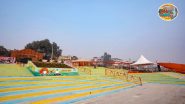Washington D.C. [U.S.A.], Jun 19 (ANI): Turns out, rush hour metro crowd is governed by people's eagerness to go home.
The new study, conducted by Springer, examined the relative role of random interactions between individuals in a crowd, compared to interactions stemming from their eagerness to be on their way.
Mathematician Carlo Bianca and physicist Caterina Mogno developed a new model to study the movement of crowds exiting a metro station.
They employed models typically used to study gases consisting of a large number of molecules that collide at random (known as thermostatted kinetic theory) to study the consequences of the different interactions occurring among pedestrians in a crowd while exiting a metro station.
The authors assumed that what motivates pedestrians to leave a metro station can be modelled as an external force that explains the conditions under which they leave due to the crowd pressure.
Their model combined aspects representing the interactions between pedestrians and governed by thermostatted kinetic theory with the cooperation between pedestrians as intelligent and self-organised decision-makers, which is governed by game theory.
The model thus depicted what happens to a crowd of pedestrians trying to leave a metro station consisting of different exits at rush hour.
Bianca and Mogno sought an approximate solution to the problem by starting from the exact solution of a simpler, related problem.
The results showed how, as pedestrians try to make their way out of the station, the interaction dynamics among them can in fact be negligible, as they do not influence the flow of pedestrians toward the exit as much as their motivation to leave (the external force) does.
Numerical simulations on the magnitude of the external force explained how internal interactions between pedestrians can be affected by an external force driving them to leave the station. What mattered most is that all of the pedestrians are individually in the same hurry to exit the station and get away from the crowd.
The latter aspect was gauged by a thermostat modelling the temperature of the molecules in a gas, which represented the individuals in the crowd, who are under a steady level of crowd pressure pushing them toward the exit.
The study appears in the journal European Physical Journal Plus. (ANI)
(This is an unedited and auto-generated story from Syndicated News feed, LatestLY Staff may not have modified or edited the content body)













 Quickly
Quickly





















